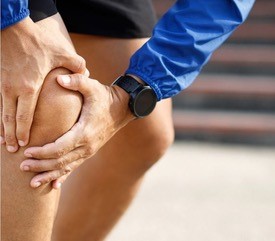Patellofemoral pain syndrome (PFPS) is characterised by diffuse, anterior knee pain which occurs particularly during running, stair climbing or squatting activities. When the knee is bent (flexed), the compressive forces within the knee joint increase. With repeated stress or strain on the knee joint, the joint may develop inflammation which causes irritation and pain. PFPS commonly occurs in young, active people who place repetitive stress through the patellofemoral joint when playing sports such as netball, soccer, basketball and touch football.
Common Signs, Symptoms and Risk Factors:
- Gradual onset of anterior knee pain
- Pain on running, squatting, lunges, stair climbing, or any activities that involve bending the knee, usually in a loaded or weight bearing position
- Usually affects females more than males

Common Causes:
PFPS is said to be a multifactorial condition – one that has a variety of factors influencing its onset. The key is to identify which factors are contributing to YOUR knee pain, and have your Physio develop and implement a rehabilitation program addressing any underlying factors. Your intervention should be targeted to you and your goals, be sport specific and will allow you to prevent any future occurrences of knee pain.
Things that may contribute to PFPS:
- Overuse or overload of the patellofemoral joint
- Biomechanical abnormalities
- Muscular weakness, tightness, imbalance or dysfunction
Slight deviation, misalignment or incorrect glide of the patella (kneecap) within its groove is often a contributing factor which can cause overload or pressure on the patellofemoral joint which can lead to pain and discomfort. Muscular imbalances can be the cause of patella deviation and aggravate PFPS. For example, when the outer quadriceps muscle (vastus lateralis) exerts a higher force or overpowers a weak VMO (vastus medialis oblique) the patella may be pulled laterally or tilted which can lead to anterior knee pain. Tightness in the hamstrings or gastrocnemius (calf) muscles as well as weakness in the gluteal muscles have also been proven to contribute to the onset of PFPS. Poor gluteal control can lead to dynamic lower limb instability and increased forces through the medial knee joint. Biomechanical abnormalities at the foot or hip should also be assessed in a thorough Physiotherapy examination to identify any potential causes of PFPS and be addressed in a comprehensive rehabilitation program.
What can your Physio do to help?
Physiotherapists are able to reduce the immediate pain and inflammation, identify the factors contributing to your pain, and develop an appropriate exercise rehabilitation program specifically for you. At your appointment, your Physio will:
- Identify whether your symptoms match the stereotypical clinical presentation of PFPS
- Ask questions to determine the onset and type of pain you’re experiencing and what activities bring on your pain
- Perform a physical examination of your knee including special tests to rule out any serious pathologies
- Assess your ability to perform functional movements such as jogging or squatting
- Assess the range of motion, strength, flexibility and control of your muscles
- Develop an individualised treatment and rehabilitation plan including exercises to correct muscle imbalances or address biomechanical abnormalities
- Provide you with education regarding your condition, the treatment and rehabilitation plan and strategies to manage your pain
- Show you some taping strategies to assist in alleviating your pain (see a demo below)
https://www.instagram.com/tv/CNB8BhIAADI/?utm_source=ig_web_copy_link
- Assist you in getting back to your sports and activities as soon as possible!
What is the prognosis for patellofemoral pain?
Most people with PFPS can achieve a full resolution of their pain. Sometimes this may take 4 weeks and in other cases it could take 3 months. How long your rehabilitation will take can depend on many factors including how long you have had the issue, how good your strength and function is and how good your motor control is. After your first consultation your physiotherapist should be able to predict a more accurate timeframe for you.
Keeping the pain at bay (once it has resolved) also means you need to be compliant to a long term prevention program which minimises the recurrence of the issue.
If you or someone you know are experiencing knee pain feel free to contact our friendly team on 9672 6752 (Kellyville) or 9871 2022 (Carlingford) to make an appointment.

